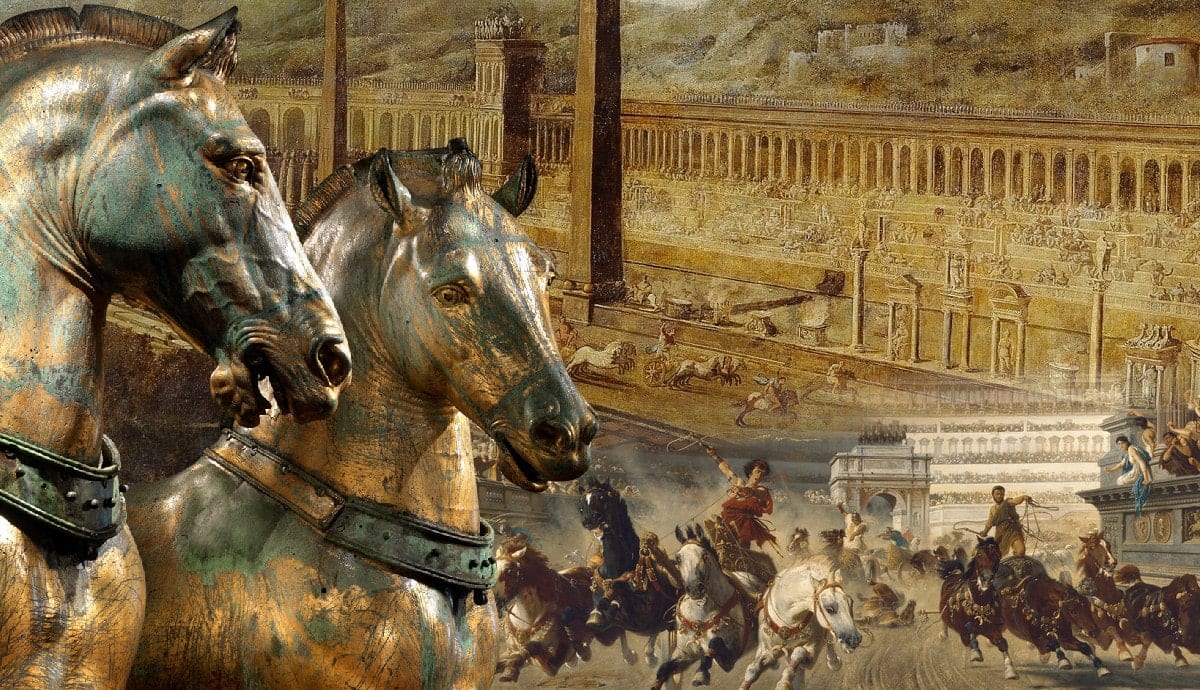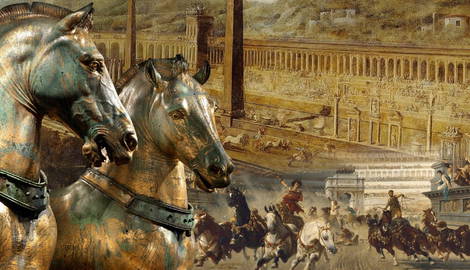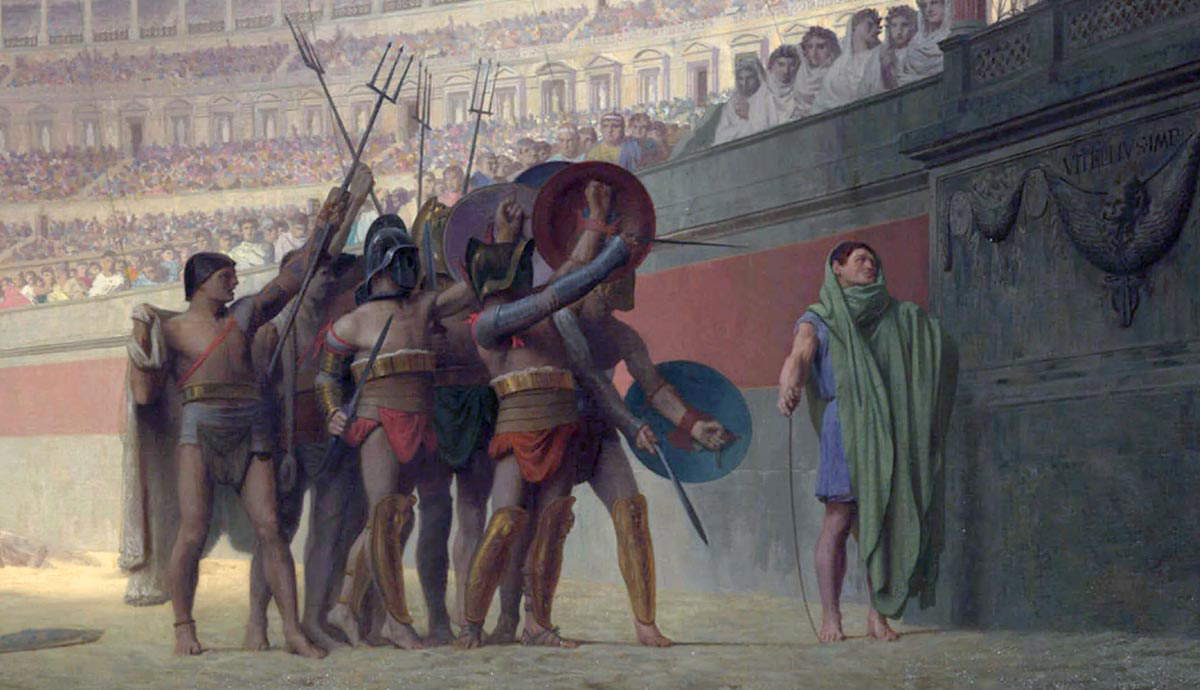
For ancient Romans, nothing was more sensational than chariot racing. Grand arenas, located in major imperial cities, were places of lavish spectacles, organized by the emperors to boost their popularity and prestige among the people. Chariot drivers would mesmerize their spectators with displays of daring courage, skillful horsemanship, and tactical ingenuity as they strove for victory through a combination of speed, strength, and risk. The lucky winner could turn into a superstar, gaining fame and a good deal of fortune. But grandiose racetracks were more than sporting arenas. The most famous of them, the Circus Maximus in Rome and the Hippodrome in Constantinople, were the social and political hearts of the two imperial capitals. They were places where common people had a rare opportunity to see their emperor, and more importantly, engage in discussion with the imperial majesty. In the sixth century’s Constantinople, one of such discussions went wrong, resulting in a horrible massacre known as the Nika riot.
The Evolution Of Chariot Racing In The Ancient World

The first chariot appeared in the Bronze age as a vehicle of war. Lightweight and agile, it was the most powerful unit in the armies of the ancient empires such as Egypt, Assyria, or Persia. Greeks, and later, Romans, did not use chariots in battle, relying on infantry instead. Chariots, however, preserved a special place in their culture. Gods raced fiery chariots across the sky, while earthly rulers and high priests used them in religious and triumphal processions. However, those imposing vehicles gained popularity in sports events.
For ancient Greeks, chariot racing was an important part of the Olympic games. Two-horse (biga) and four-horse (quadriga) chariots led by amateur charioteers raced on a racetrack called hippodrome, with up to sixty chariots participating in the same race. This made chariot racing dangerous. One of the documented events reported a crash of up to forty chariots. The very term for the crash – naufragia (shipwreck) evokes the dangers and horrors of this sport. Greeks exported chariot racing to Italy, where it was adopted by the Etruscans around the 6th century BCE. Romans, who shared the Etruscan need for speed, turned chariot racing into a mass entertainment spectacle.

In imperial Rome, racing became a professional sport, with stars and teams funded by private owners and municipalities. Most of the athletes were slaves, who could earn their freedom, fame, and fortune, by winning in the races. All charioteers belonged to one of the four principal circus factions: Blues, Greens, Whites, and Reds (named after colors worn by both the athletes and fans). Like the professional football teams of today, the factions had hordes of fanatical followers, including the emperor himself. Drivers could change factions, but fans did not. Writing in the first century CE, Pliny the younger criticized this partisanship and Roman obsession with games. The importance of chariot racing in the Roman empire was further emphasized by the grandiose arenas where the games took place.
The Sporting Arenas: The Circus Maximus And The Hippodrome

Due to the sport’s massive popularity, a racetrack (named circus, due to its oval shape) could be found in all major cities scattered across the Roman empire. The biggest and most important among them was the Circus Maximus in Rome. Originally just a flat sandy track, the area gradually developed into a grandiose stadium-style building with a central divider (spina), and a host of accompanying structures, as well as a two-tiered sitting platform. The Circus Maximus was the largest and most expensive edifice in the capital. At its peak, during the 1st century CE, it could contain at least 150 000 spectators (for comparison, Colosseum’s maximum capacity was 50 000).
The second important sporting arena in the empire was the Hippodrome in Constantinople. Built by emperor Septimius Severus in the 3rd century CE (when the city was known as Byzantium) it got its final form hundred years later, under Constantine the Great. Following the usual rectangular shape, with an oval end, the Hippodrome was the largest building in Constantinople and the second-largest stadium after the Circus Maximus. It could house from 30,000 to 60,000 people.

Both the Circus Maximus and the Hippodrome were more than grandiose sporting venues. As the largest edifices in the capital, they were a huge employment source, hiring athletes, managers, horse trainers, musicians, acrobats, sand rakers, and vendors. Moreover, these magnificent stadiums were the centers of the cities’ social and political life. There, people could communicate with their emperor and a good place for the ruler to solidify his position.
These grand arenas were the ultimate symbols of imperial power. Besides the monuments to charioteers and their horses, the spina was filled with statues of gods, heroes, and emperors. Both the Circus Maximus and the Hippodrome had majestic ancient obelisks brought from distant Egypt as centerpieces. In Constantinople, the carefully chosen works of art, such as Romulus and Remus with the she-wolf, and the Serpent Column from Delphi, emphasized the city’s principal status.
Fast And Furious: A Day At The Races

Initially, chariot races were held only at religious festivals, but from the Late Republic onwards, they would be held on non-festive days as well. On those occasions, the games would be sponsored by prominent Roman dignitaries, including the emperor himself. Unlike present-day sporting events, the entry for a spectacle was free of charge for the common people and the poor. The elites had better-designated seats, but every stratum of society – slaves and aristocrats, men and women – would gather together at the same place to enjoy the spectacle.
Truly, it was a spectacle! The most lavish of all the events – the imperial games held in the capital – included up to twenty-four chariot races per day. More than a thousand horses would run in a single day. A lightweight, wooden chariot drawn by four horses and piloted by a man tied by the waist to the reins, steering with his weight, was a thrilling sight. A charioteer would have to complete seven laps, careering around corners at dangerously high speeds, avoiding other chariots, and the ever-present present danger of a crash, maiming, and often, death. No wonder that chariot races generated a delirious atmosphere of thrill and excitement.

Chariot racing was a sport that involved both the athletes and the spectators. While racing, the charioteers were roared on by a huge crowd, which created a cacophony alien to our ears. Think modern football games, or car races, but much, much louder. Running out into the field to interrupt a game sounds pretty tame compared to throwing nail-studded curse tablets onto the track in an attempt to disable their champions’ rivals. Dirty tricks were encouraged by the gambling mania that involved both the athletes and spectators, who could win or lose a small fortune betting on their favorites.
Charioteers: The Superstars Of The Ancient World

Chariot racing was an extremely dangerous sport. Ancient sources are filled with records of the famous racers in their youth, crushed against the spina or dragged on by the frenzied horses after the chariot was smashed. Even outside the field, sabotage was common. However, if a charioteer was lucky enough to win, he could earn a substantial amount of money. If a charioteer survived many races, he then became an ancient superstar rivaling senators in wealth and a living god inspiring legions of his fans.
Diocles
The greatest charioteer of the ancient world and the wealthiest sportsmen ever was Gaius Appuleius Diocles, who lived in the second century CE. Diocles won 1,462 of 4,257 races, and more importantly, retired in good health, which was a rarity in this dangerous sport. When he retired, Diocles’ total winning amounted to nearly 36 million sesterces, a sum sufficient to feed the whole city of Rome for a year, or to pay the Roman army at its height for a fifth of a year (unofficial estimate is the equivalent of $15 billion today). It is no wonder that his fame put the emperor’s popularity to shame. Scorpus was another famous charioteer, whose brilliant career of 2 048 victories was cut short by a crash when he was only 26 years old.
Porphyrius

The most famous charioteers were honored with monuments raised on the spina after their death. This was not the case with Porphyrius, the charioteer who raced in the 6th century CE. Porphyrius continued racing in his 60s and is the only known charioteer who was honored by a monument during his life. Seven monuments were raised in his honor at the Hippodrome’s spina. Porphyrius is also the only known charioteer who raced for opposed circus factions (Blues and Greens) on the same day and won on both occasions. His fame and popularity were so great, that both factions honored him with monuments.
The Nika Revolt: When The Races Turned Violent

Writing in the early 2nd century CE, poet Juvenal bemoaned how Roman people’s attention was easily diverted from important matters by “bread and circuses.” This sounds familiar, since present-day sporting arenas also serve as a source of distraction. But for many ancient Romans, chariot racing was an essential part of political life. The people could use the Emperor’s rare public appearance to express their opinions or ask for concessions from the ruler. For the emperor, a day at the races was an opportunity to show his benevolence and boost popularity, as well as a good place to gauge public opinion.
The political dimension of chariot racing further increased in the late Empire, as the emperors spent most of the time in their new capital, Constantinople. The Hippodrome was directly connected to the Great Palace, with the ruler presiding over the races from a specially designed private loge (kathisma). The circus factions’ political role also increased, with the people chanting their demands during the competitions, while the Blue-Green rivalry could often erupt into gang warfare and street violence. One such incident led to the worst massacres in the history of chariot racing: the Nika riot.

On January 13th 532 CE, a crowd assembled at the Hippodrome appealed to emperor Justinian, to show mercy to the factions’ members condemned to death for their crimes during an earlier riot. When the emperor remained unmoved by their cries, both the Blues and Greens started shouting “Nika! Nika”! (“Win!” or “Conquer!”). Normally, this was a cheer addressed to the charioteer, but now it became a battle cry against the emperor. Five days of violence and looting followed while the city burned. Besieged in the palace, Justinian tried to reason with the people and failed. To make matters worse, some of the senators who disliked the emperor exploited the chaos to install their candidate for the throne.
According to Procopius, the situation was so desperate that Justinian planned to flee the city, but was dissuaded by his wife, Empress Theodora. Finally, his generals devised a plan to restore order and take control of the city. Emboldened, Justinian sent his troops to the Hippodrome who made short work of the assembled crowd, leaving as many as 30,000 people, Greens and Blues alike, on the arena’s floor. From now on, the Blues and Greens would retain only a ceremonial role.
The Impact Of Chariot Racing

The Nika riot crushed the power of the circus factions. A century later, the sport’s popularity declined. Preoccupied with Persian, and later Arab invaders, the emperors found it increasingly difficult to finance the Hippodrome games. Public events, including executions and festivals (and even western-style jousting in the 12th century), continued until 1204, when the city was sacked during the Fourth Crusade. The conquerors plundered the city, including the Hippodrome’s vaunted monuments. The gilded bronze quadriga, which once topped the monumental entrance of Constantinople’s grand arena, was taken to Venice, where it can be seen today, in the Basilica di San Marco.
Chariot racing was a sport unlike any other in the Roman world. It was a thrilling spectacle that appealed to all social classes, from slaves to the emperor himself. The grand arenas like the Circus Maximus or the Hippodrome were centers of social life and sources of pleasure for the people who fervently backed their favorite factions. Skilled charioteers braved many dangers, and if successful, they could turn into superstars, rivaling the emperor’s fame. But chariot races were more than than a sport. They played an essential role in the empire’s political life, offering the emperor a rare opportunity to communicate with his people. Races also served as a source of distraction, preventing potential riots. Ironically, it was one of the games that sparked the worst riot in imperial history and brought the end of chariot racing to a close.

Centuries after the last dolphin signified the end of chariot racing, and the Roman empire ceased to exist, the grand arenas’ magnificence is still visible. The Circus Maximus’ contours and the remains of the Hippodrome’s spina remind onlookers of their past glory. The magnificence and frenzy of chariot racing are immortalized in a Hollywood historical epic Ben-Hur. Although the fanatical faction supporters are long gone, Juvenal’s comment about “bread and circuses” and Pliny’s criticisms of partisanship are still relevant to our society. Diocles or Porphyrius would probably laugh at the pains of modern stars like Ronaldo or Messi. But they would be at home with the culture of fiercely dedicated sport worship and hooliganism.
Some things never change.










